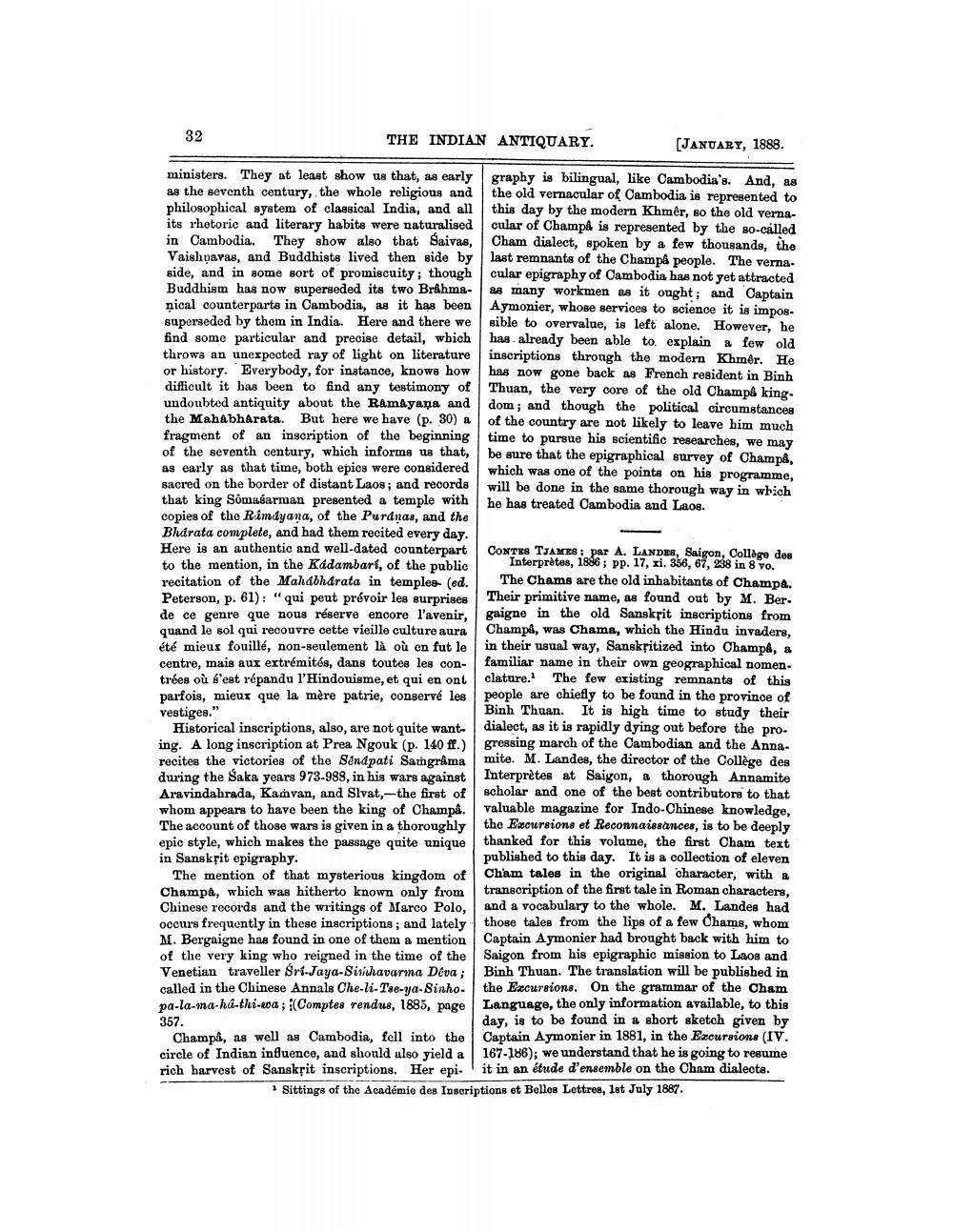________________
32
THE INDIAN ANTIQUARY.
(JANUARY, 1888.
ministers. They at least show us that, as earlygraphy is bilingual, like Cambodia's. And, as as the seventh century, the whole religious and the old vernacular of Cambodia is represented to philosophical system of classical India, and all this day by the modern Khmer, so the old vernaits rhetoric and literary habits were naturalised cular of Champå is represented by the so-called in Cambodia. They show also that Saivas, Cham dialect, spoken by a few thousands, the Vaishpavas, and Buddhists lived then side by last remnants of the Champå people. The vernaside, and in some sort of promiscuity; though cular epigraphy of Cambodia has not yet attracted Buddhism has now superseded its two Brahma- as many workmen as it ought; and Captain nical counterparts in Cambodia, as it has been Aymonier, whose services to science it is impossuperseded by them in India. Here and there we sible to overvalue, is left alone. However, he find some particular and precise detail, which has already been able to explain a few old throws an unexpected ray of light on literature inscriptions through the modern Khmer. He or history. Everybody, for instance, knows how has now gone back as French resident in Binh difficult it has been to find any testimony of Thuan, the very core of the old Champå king. undoubted antiquity about the Ramayana and dom; and though the political circumstances the Mahabharata. But here we have (p. 30) a of the country are not likely to leave him much fragment of an inscription of the beginning time to pursue his scientific researches, we may of the seventh century, which informs us that, be sure that the epigraphical survey of Champa, as early as that time, both epics were considered which was one of the points on his programme, sacred on the border of distant Laos; and records will be done in the same thorough way in which that king Sómasarman presented a temple with he has treated Cambodia and Laos. copies of the Rimdyana, of the Puranas, and the Bhdrata complete, and had them recited every day. Here is an authentic and well-dated counterpart CONTES TJAMES : par A. LANDES, Saigon, Collage dos to the mention, in the Kadambari, of the public Interprètes, 1886; Pp. 17, xi. 356, 67, 238 in 8 vo. recitation of the Mahabharata in temples (ed.
The Mohabharata in temple (ed. The Chams are the old inhabitants of Champa. Peterson, p. 61): "qui peut prévoir les surprises Their primitive name, as found out by M. Ber. de ce genre que nous réserve encore l'avenir, gaigne in the old Sanskrit inscriptions from quand le sol qui recouvre cette vieille culture aura Champå, was Chama, which the Hindu invaders, été mieux fouillé, non-seulement là où en fut le in their usual way, Sansksitized into Champå, a centre, mais aux extrémités, dans toutes les con- familiar name in their own geographical nomentrhan où l'est répandu l'Hindouisme. et qui en ont clature. The few existing remnants of this parfois, mieux que la mère patrie, conservé les people are chiefly to be found in the province of vestiges."
Binh Thuan. It is high time to study their Historical inscriptions, also, are not quite want- dialect, as it is rapidly dying out before the proing. A long inscription at Prea Ngouk (p. 140 ff.) gressing march of the Cambodian and the Annarecites the victories of the Sandpati Samgråma mite. M. Landes, the director of the Collège des during the Saka years 973-988, in his wars against Interprètes at Saigon, a thorough Annamite Aravindahrada, Kanvan, and Slvat,--the first of scholar and one of the best contributors to that whom appears to have been the king of Champå. valuable magazine for Indo-Chinese knowledge, The account of those wars is given in a thoroughly the Excursions et Reconnaissances, is to be deeply epic style, which makes the passage quite unique
thanked for this volume, the first Cham text in Sanskpit epigraphy.
published to this day. It is a collection of eleven The mention of that mysterious kingdom of
Cham tales in the original character, with a Champa, which was hitherto known only from transcription of the first tale in Roman characters, Chinese records and the writings of Marco Polo, and a vocabulary to the whole. M. Landes had occurs frequently in these inscriptions; and lately those tales from the lips of a few Chams, whom M. Bergaigne has found in one of them a mention Captain Aymonier had brought back with him to of the very king who reigned in the time of the Saigon from his epigraphic mission to Laos and Venetian traveller Sri-Jaya-Sirishavarma Diva ; Binh Thuan. The translation will be published in called in the Chinese Annals Che-li-T'se-ya-Sinho. the Excursions. On the grammar of the Cham pa-la-ma-hd-thi-noa ; :(Comptes rendus, 1885, page Language, the only information available, to this 357.
day, is to be found in a short sketch given by Champå, as well as Cambodia, fell into the Captain Aymonier in 1881, in the Excursions (IV. circle of Indian influence, and should also yield a 167-186); we understand that he is going to resume rich harvest of Sanskrit inscriptions. Her epi. it in an étude d'ensemble on the Cham dialecta.
* Sittings of the Académie des Inscriptions et Bellos Lettros, 1st July 1887.




